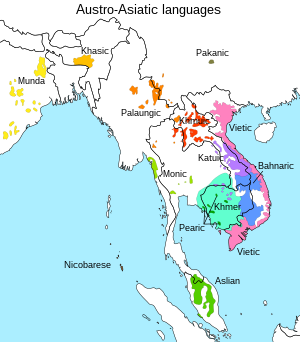
Back Austro-Asiatiese tale Afrikaans لغات أسترو آسيوية Arabic Llingües austroasiátiques AST Avstroasiya dilləri Azerbaijani آوسترو آسیا دیللری AZB Mga tataramon na Austroasyatiko BCL Аўстраазіяцкія мовы Byelorussian Аўстраазіяцкія мовы BE-X-OLD Австроазиатски езици Bulgarian অস্ট্রো-এশীয় ভাষাসমূহ Bengali/Bangla
| Austroasiatic | |
|---|---|
| Austro-Asiatic | |
| Geographic distribution | Southeast, South and East Asia |
| Linguistic classification | One of the world's primary language families |
| Proto-language | Proto-Austroasiatic |
| Subdivisions | |
| Language codes | |
| ISO 639-5 | aav |
| Glottolog | aust1305 (Austroasiatic) |
 | |
The Austroasiatic languages[note 1] (/ˌɒstroʊ.eɪʒiˈætɪk, ˌɔː-/ OSS-troh-ay-zhee-AT-ik, AWSS-) are a large language family spoken throughout Mainland Southeast Asia, South Asia and East Asia. These languages are natively spoken by the majority of the population in Vietnam and Cambodia, and by minority populations scattered throughout parts of Thailand, Laos, India, Myanmar, Malaysia, Bangladesh, Nepal, and southern China. Approximately 117 million people speak an Austroasiatic language, of which more than two-thirds are Vietnamese speakers.[1] Of the Austroasiatic languages, only Vietnamese, Khmer, and Mon have lengthy, established presences in the historical record. Only two are presently considered to be the national languages of sovereign states: Vietnamese in Vietnam, and Khmer in Cambodia. The Mon language is a recognized indigenous language in Myanmar and Thailand, while the Wa language is a "recognized national language" in the de facto autonomous Wa State within Myanmar. Santali is one of the 22 scheduled languages of India. The remainder of the family's languages are spoken by minority groups and have no official status.
Ethnologue identifies 168 Austroasiatic languages. These form thirteen established families (plus perhaps Shompen, which is poorly attested, as a fourteenth), which have traditionally been grouped into two, as Mon–Khmer,[2] and Munda. However, one recent classification posits three groups (Munda, Mon-Khmer, and Khasi–Khmuic),[3] while another has abandoned Mon–Khmer as a taxon altogether, making it synonymous with the larger family.[4]
Austroasiatic languages appear to be the extant autochthonous languages in mainland Southeast Asia, with the neighboring Kra–Dai, Hmong-Mien, Austronesian, and Sino-Tibetan languages having arrived via later migrations.[5]
Cite error: There are <ref group=note> tags on this page, but the references will not show without a {{reflist|group=note}} template (see the help page).
- ^ "Austroasiatic". www.languagesgulper.com. Archived from the original on 29 March 2019. Retrieved 15 October 2017.
- ^ Bradley (2012) notes, MK in the wider sense including the Munda languages of eastern South Asia is also known as Austroasiatic.
- ^ Diffloth 2005
- ^ Sidwell 2009
- ^ Cite error: The named reference
SidwellBlench2011was invoked but never defined (see the help page).